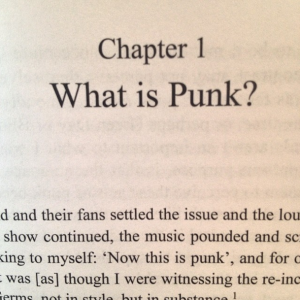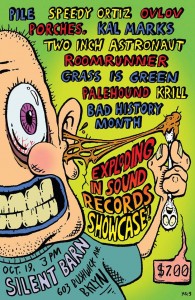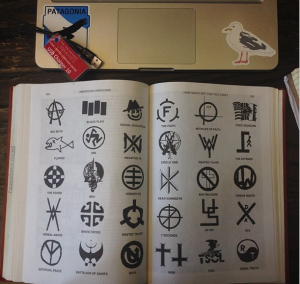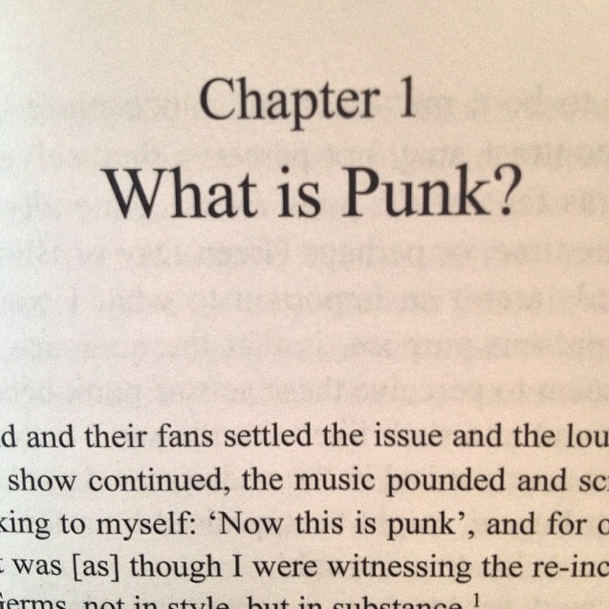
Hello Everyone!
It has been the most hectic summer of my life – I began this project trying to define why New York is still a mecca for musicians, creative types, etc. despite its costliness and ended up feeling fairly apathetic by August. I am amazed by the way that my personal life came to mirror the sentiment of my project. I found myself going to shows not because I wanted to collect field notes or talk to people or try to build connections, but because I needed a distraction from life in the city, a reminder of why I ~should~ love it. After a challenging first month, investigation became much easier, and writing began to form in fragments that are not yet wholly cohesive or coherent, but soon will be. I read countless zines, scoured diaries and demographic census reports made by the city of New York. Above all, I began to notice things about Brooklyn that I would have blown off, or made fun of before. Just before sitting down to write this, I pointed out three new luxury apartment developments popping up all over Bedstuy to a friend. These buildings have no apparent thing to do with locally built DIY venues in New York, but they represent the cycles of gentrification that keep these musical spaces moving.

Since my last post, I have been focusing mainly on writing about my discoveries by breaking down my research into chapters held together by a few common threads. I hope to be able to eventually compile them into a solid long-form article or multi-part essay. Thus far I have written chapters focusing on 1970s New York as a catalyst for the city becoming a kind of “dreamscape” for aspiring musicians. From there, I have been focusing on writing an analysis of the notion of DIY culture as being something exclusively related to post-punk music of the 1980s and the hardcore scene that emerged at that time. I happened across an oral history of Hardcore entitled “Hardcore: A Tribal History” while scouring the stacks at Bobst and have taken a significant amount of my contemporary DIY definitions from this older conception. Additionally, I became obsessed with a zine, published in 2001, entitled “DIY: New York” that reflects on the DIY fest movement happening in NYC in the early 2000s. Both the book and zine offered me a fascinating idea that ties closely in with my demographic analysis of the city.

These are two contradictory thoughts that have kept me excited about the project:
- The DIY ethos is a perfect example of the American Dream coming to fruition.
- Because DIY culture is at its core anti-capitalist, it is not easily adapted to the American mainstream.
Using this idea, I’ve been attempting to define what is now called a “DIY venue” in New York as a sort of hybridization of the status-quo and the underground. Mid-August, I am going to work on a visual mapping project, in which I will draw up a map of the city and list the insane number of underground, or counter-cultural venues that continue to exist, or have already disappeared.
I hope to get this map printed in order to distribute, in an effort to make some of these places more accessible.
Thanks for reading!
G

Hey Gabrielle!
Good hearing from you, and thanks for commenting! This was such a helpful post as it made me take some larger concepts into consideration that I had not thought to include. Perhaps the most intriguing of the ideas that you brought up is the importance of time, or perhaps, the passage of time, as playing a crucial role in these musical migrations. Something that I have spent a lot of time looking into is the way in which punk has become aestheticized to the point that its original “look” and sound are far removed from what developed into cultural capital. It is publicly known that 285 Kent shut its doors in order to avoid BEING shut down in the future. With high rises dominating the Williamsburg skyline, it comes as no surprise that the venue in a huge warehouse space would likely lose its lease sometime in the near future. Sure enough, this summer, VICE (HBO owned media conglomerate) announced that they will be moving into 285’s warehouse. When it was announced that VICE was moving in, internet music dorks freaked out about one of the oldest DIY spaces, Death By Audio (or, DBA) would be shut out by the huge media company as well (they operate out of the same building). DBA is safe for now, but the irony of the situation is that if you ever read VICE magazine, or their music blog Noisey, you can see that they champion the musical aesthetic that venues like 285 and DBA cultivate. So what does this say about gentrification, or as Christopher Mele would say “hip urban renewal”? It essentially says that cultural hubs birth a movement that grows into something easily marketed by ~capitalist America~, and then moves on. So yes, yuppies kill these places, but these venues foster a kind of cultural capital that, unfortunately, is hugely marketable at the moment, especially as Brooklyn becomes more and more of a buzzword throughout the world (case in point: I can’t even tell you how many Brooklyn-related t-shirts I saw in Argentina). I am not trying to say that these venues are killing themselves by becoming popular, I am simply trying to point out the idea that community leaders, real estate developers, everyone who has a say in what stays in a neighborhood and what goes, should be looking at negative space. What does Williamsburg lose if DBA is forced out? It loses one of, if not the last piece, of a musical renaissance that began in the late ’90s and early 2000s in Brooklyn. I am not trying to say that with the passage of time, movement and change is inevitable, I just think that it’s important for anyone involved to see past legality, dollar signs, etc. and acknowledge what is lost when these landmarks disappear.
As far as the American Dream goes… I think that this is it. Building something from the ground-up, maybe Doing it Yourself or Doing it Together and watching it spawn new places with a similar ethos, and then letting it die when you know it’s time. That probably sounds dark, but if there’s anything I’ve learned thus far, it’s that these places might close after only a few years, but the people running it, the people going to shows, are still hanging out — it’s a human-fueled effort rather than a $money$-fueled effort. Money dries up, but most of the people involved in this culture are probably going to stick around.
Thanks again!
Gabriela
Gabriela!!
This sounds like an amazing project, one that I am really excited to read, walk through, listen to, and attend. I am also really interested in DIY venues and aesthetics, along with, of course, the music, art, and poetry that power both. Thinking about these things often makes me feel apathetic too, but I’m glad you have continued to work through your project. Here are some questions I have always or recently begun to have about the DIY scene or anti-scene, and was hoping you could answer them or just think about them in your project. They echo many of the points you brought up in your post:
1. What role does time play in a DIY space and the utopia it becomes or promises? How long can a DIY space last or be constituted as DIY before, like so many neighborhoods in New York, it begins to be colonized by attention or people that regulate or attempt to capitalize, culturally or monetarily on, that space? What role does cultural capital play in Punk? (I’m thinking both about “posers” and people who consider themselves “true punks” but often look down on those who don’t fall into the aesthetic category of punk but are still mentally committed to punk, and exclude them in a way that is, to me, quite un-punk) I also heard recently that the owner of 285 Kent shut it down because Williamsburg had become too yuppified for the venue to operate in the way he originally wanted it to (you talked about the space in your last post, and it was always meh for me too but nonetheless…) What do you think about this action? Is it more radical to stay and weather the yuppies, or to keep the scene in flux?
2. What is the exchange between neighborhood and venue? Is something even more punk for being radical in an oppressive or regulated area?
3. I’m really interested in your idea that the DIY ethos works toward an American Dream of its own–I’ve found that many artists/poets/musicians (Whitman, the Beats, Patti Smith, Riotgrrls, etc) tried to reconceptualize the American Dream in their work and life. I also think it’s really smart of you to bring up the way that DIY contradicts that hyper-capitalistic spirit of America and the traditional American Dream. What is America to the DIY ethos? Why is America worth fighting for or against, for practitioners of the DIY ethos? Big questions, but I think you’re onto some answers.
Good luck, and let me know of any cool shows/spaces you find out about!
—–~Gabrielle